Ladybugs are generally seen as beneficial species of bugs as they eat invasive pests such as aphids.
It’s estimated there are thousands of ladybug species around the world. Up to 400 species are common across the US and Canada alone.
Some of the ladybugs in North America are native while others have an introduced status.
A few species eating aphids and scale insects have been introduced to crops and greenhouses as a natural pest control solution.
Known for their positive role in the ecosystem, ladybugs come from different species all around the world.
Often identified by the number of spots across the elytra, ladybugs can also come without spots and in different colors.
Most ladybugs are efficient predators. They favor smaller and softer insects that are easier to consume. They can sometimes consider even larger insects compared to their own size.
Ladybugs can grow in population in areas with abundant prey. They can also move locations to an area with sufficient food.
Competition between various ladybug species might also limit the spread of the increase in population numbers.
Table of Contents
Ladybug Identification
Some ladybug species only come in a single color while other types of ladybugs may come in different colors and sizes.
Ladybug colors
Ladybugs can be white, red, yellow, orange, brown, pink, or black. Different nuances of these colors exist.
Spots on spotted ladybugs are mostly black or red, or white.
Ladybug size
Ladybugs in North America come in different sizes. They range between smaller 2mm and extreme 10.5mm sizes.
Many species of North American ladybugs measure an average size between 4 and 6mm.
Ladybug habitat
Ladybugs inhabit both dry and humid habitats in the valley, prairies, tundra, and high elevation.
They can live on short vegetation, and crops or may be entirely arboreal.
As predatory species, ladybugs only live in areas with soft-bodied insects they eat.
To a lesser extent, ladybugs might sometimes eat pollen, nectar, or mildew.
Types of Ladybugs
Some of the most common ladybugs can be found among the following species.
1. Asian Ladybug

These Asian-origin ladybugs (Harmonia axyridis) have widespread distribution around the world.
Multiple colors and patterns are specific to these ladybugs that grow to about 5.5mm.
Since they come in red, orange, and black colors, these ladybugs might be difficult to correctly identify.
A specific M-shaped or W-shaped mark on the prothorax is one of the easiest ways of identifying the Asian Ladybug.
This species has been widely accepted as beneficial in the pest-control situation on crops.
Asian Ladybugs are used on farms and crops to control pests such as aphids or leaf-eating scale insects.
Overwintering is specific to the species but some Asian ladybugs may be seen in the winter seeking out direct sunlight for extra heat.
2. Seven-spotted Ladybug

Native to Europe, the Seven-spotted Ladybug (Coccinella septempunctata) gets its name from the 7 spots on its elytra.
Seven-spotted Ladybugs have just been established for a few daces in North America.
This species has red elytra with 3 black spots on each wing with a cross-spot that totals 7 spots.
Feeding on aphids, the ladybug has a beneficial role in agriculture.
This species can be twice as large as the Asian Ladybug at times. Smaller Seven-spotted Ladybugs measure more than 7mm while larger bugs measure more than 12mm.
The combination of larger body size and spotted elytra makes the bug less appealing to bird predators.
3. Convergent Ladybug

2 white convergent lines on a black prothorax make this ladybug species (Hippodamia convergens) different.
The species has red-to-orange elytra with 12 black spots seen across the wings.
Starting life as a small yellow egg, the Convergent Ladybug is a species commonly seen on crops where it shows its predatory behavior.
It feeds on aphids and it’s used as a pest control species. Cotton and potato aphids are among the most common species this ladybug feeds on.
While a predator itself, the ladybug also has many natural predators such as damsel bugs.
4. Spotted Pink Ladybeetle

Spotted Pink Ladybeetles (Coleomegilla maculata) come in either pink or red colors.
The species live in the same habitat as its bug prey, mainly on crops.
Corn or alfalfa crops are a common habitat for the Spotted Pink Ladybeetle.
The diet of the species is complex as the bugs are omnivores, also consuming pollen and nectar.
Hornbeam copperleaf is one of the nectar-rich species this ladybeetle is often seen on.
These bugs are naturally attracted to crops whenever anti-pest chemicals aren’t used on legumes.
5. Spotless Ladybug

This species of ladybug (Cycloneda sanguinea) has an orange or red color, a black head, and contrasting white marks.
Bugs of this genus are native to California but they’re also seen across Central and South America.
Ladybugs of this genus are routinely seen eating pollen from milkweed. Chaparral broom and aphids are also part of their diet.
A growing habitat is specific to the Spotless Ladybug with a growing presence in new environments such as in Hawaii.
6. Polished Ladybug

A red-to-orange elytron is specific to Polished Ladybugs (Cycloneda munda). This is one of the few spotless elytra North American ladybugs.
First seen in the spring, Polished Ladybugs exclusively feed on aphids.
Some areas of North America start to register a diminishing number of Polished Ladybugs, mainly due to a growing number of introduced ladybugs.
Fewer aphids and aphid larvae resources mean these ladybugs have to compete for resources with other species.
7. Fourteen-spotted Ladybug

Relatively small, the Fourteen-spotted Ladybug (Propylea quatuordecimpunctata) has a size of up to 4.5mm.
Black and yellow contrasting colors are specific to this species.
Counting the 14 spots on its elytra might be difficult as some of them are connected.
Fourteen-spotted Ladybugs are seen as a yellow species with black spots. However, there’s a black morph with yellow spots within the species.
These ladybugs also come in white elytra with black spots.
What aphids and scale insects are among its most common foods.
8. Ashy Gray Ladybug

This type of ladybug (Olla v-nigrum) has a white, gray, or tan base color across the elytra.
Tiny black spots are specific to its elytra.
The Northern limit of its habitat is the region of The Great Lakes.
Ash Gray Ladybugs are dominant in Southern US states. They are also highly common in Central America with a Northern South America habitat limit.
The size of the Ashy Gray Ladybug varies considerably from just over 3mm to a size of up to 7mm.
Correct identification can be a bit more difficult in its black morph. This morph also has 2 large red spots on the elytra.
9. Twenty-spotted Ladybug

This type of ladybug (Psyllobora vigintimaculata) has a dark brown color, an orange color, or a white color with brown or black spots.
Some of its spots are uniquely fused which makes for an easier distinction to similar species of ladybugs.
Twenty-spotted Ladybugs may also be differentiated from other species by smaller body sizes.
It’s not atypical for this ladybug to only measure 1.75mm as an adult.
It feeds on plant mildew on infested crops and it has a generally positive role attributed to its presence without needing any management measures.
10. Twice-stabbed Ladybug
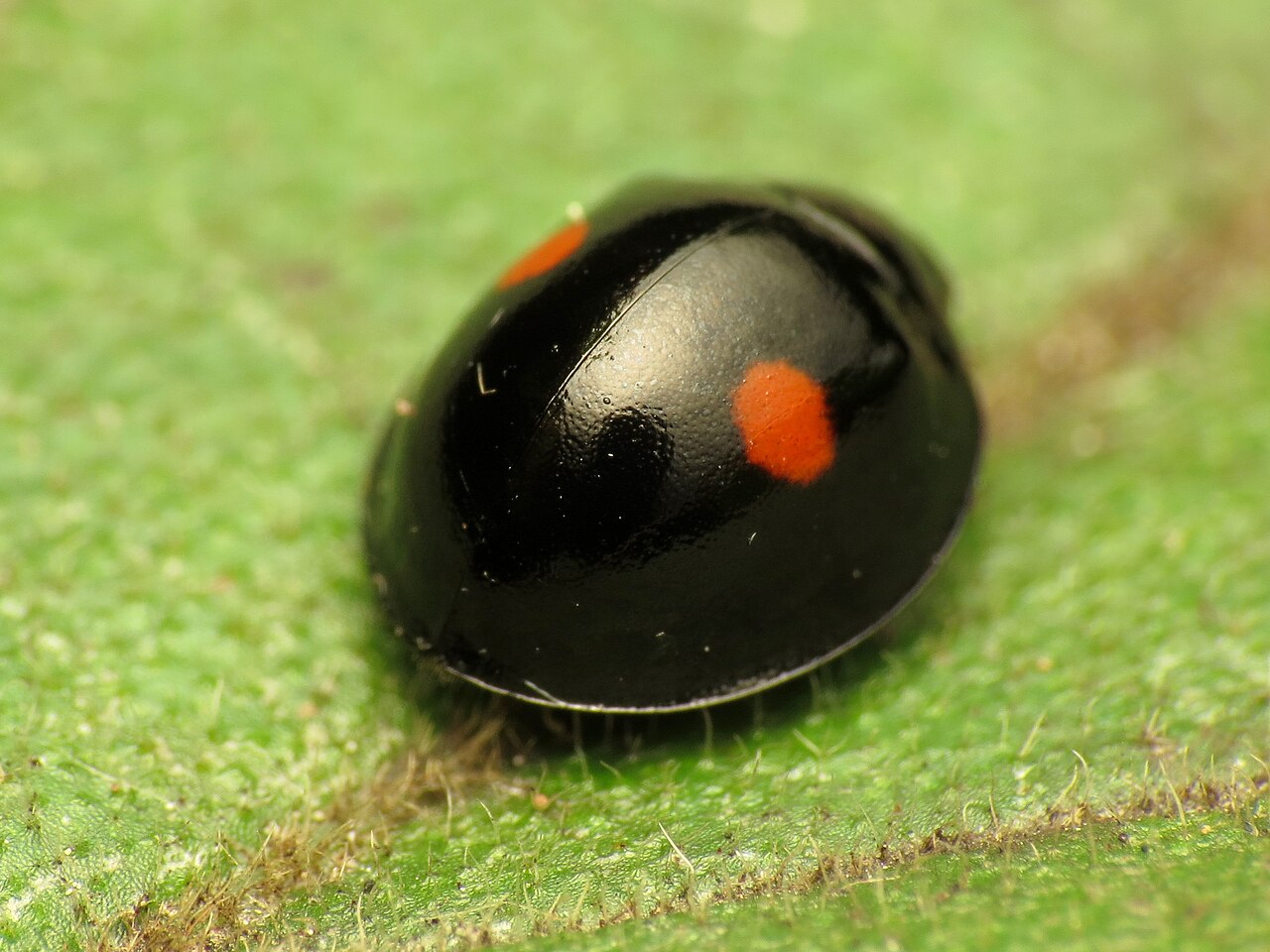
This species of ladybug (Chilocorus stigma) is a known biological control agent for various bug pests in citrus groves and other commercially-grown tree establishments.
It feeds on aphids, scale insects, and mealybugs that affect all types of trees.
The presence of the species is signaled both in Canada and in the US. It has overwintering habits in the North and an almost year-round presence in the South.
These bugs have a black body with 2 red spots on the elytra. The ventral coloring of the species is typically red.
11. California Ladybug

Native to Western US territories, California Ladybugs (Coccinella californica) are red and black. A rusty-red elytron without spots is characteristic of the species.
Small white margins are seen between the elytra and the thorax.
A black thorax with white spots is further identified in this species.
Coastal areas are known to attract the California Ladybug.
12. Mealybug Destroyer

Mealybug Destroyers (Cryptolaemus montrouzieri) are a common species across California. It’s used as a pest control agent on citrus groves as well as in greenhouses.
The species has an imported status, being traced back to Australia.
Mealybug Destroyers have a black and brown body that grows up to 4mm.
They feed on plant-eating mealybugs being natural biocontrol agents.
These bugs are most efficient in controlling greenhouse mealybugs.
13. Western Polished Ladybug

Western Polished Ladybugs (Cycloneda polita) have red elytra that lack spots or other marks.
Its pronotum is black with white circles.
Endemic to Western parts of North America, this is a species that ends overwintering in March and becomes active until late in the fall.
It’s seen up until November in California.
Washington state also reports high Western Polished Ladybug populations.
14. Squash Ladybug

This species (Epilachna borealis) has a yellow or orange color.
Large and black spots decorate its body.
Common across Eastern US states, the beetle is inspired by the squash it lives off.
It lays eggs on squash and pumpkin leaves. Both emerging larvae and the adult Squash Ladybug feed on the soft tissue of the leaves squash plants have.
Squash and pumpkins are also seen late in the season which means the ladybug survives into the fall months.
15. Variegated Ladybug
You can see the Variegated Ladybug (Hippodamia variegata) multiple continents in dry habitats such as open meadows and gardens.
The species has variable coloring and may be confused with other ladybugs.
Both a red and an orange morph are specific to the Variegated Ladybug.
Regardless of the color of its elytra, the species comes with black spots. Up to thirteen black spots are seen on the bug.
A black pronotum with white marks is also distinguished on both forms of the Variegated Ladybug.
16. Cactus Ladybug
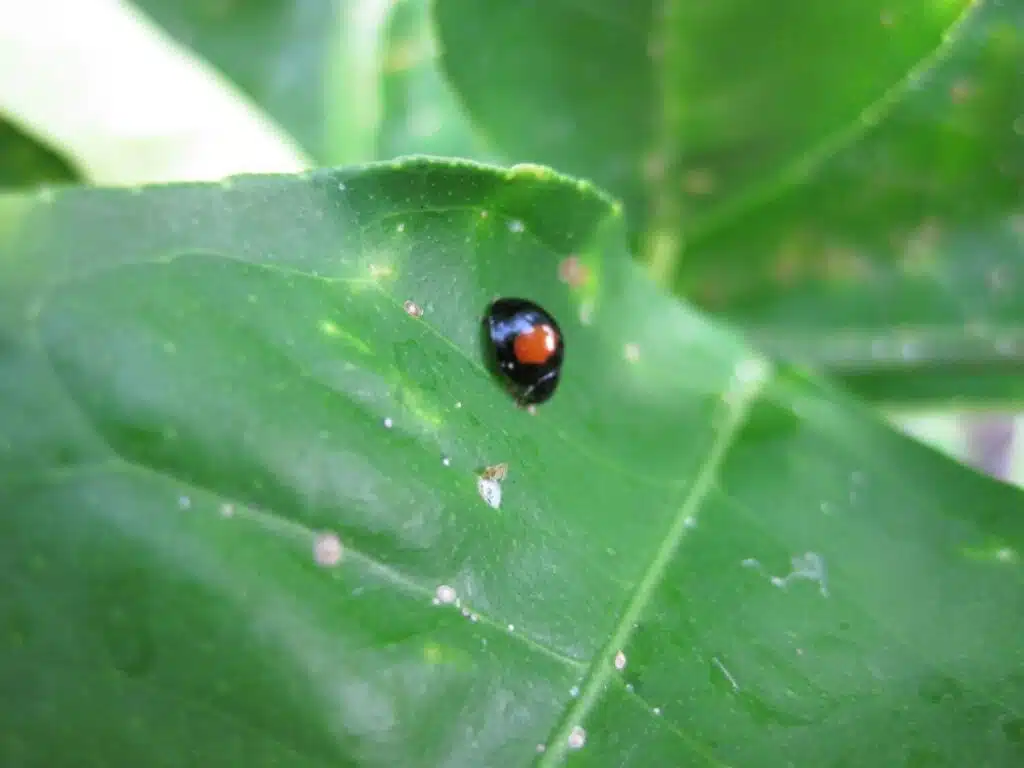
This type of ladybug (Chilocorus cacti) is tied to species of cacti such as prickly pear.
A typical dome-shaped body is specific to this ladybug.
It begins life as spiky black larvae and it becomes a black adult with 2 red spots. Cactus Ladybugs grow to a size of up to 6mm.
The black larvae and adult ladybugs eat scale insects.
While a predator from the earliest stages of its life, the Cactus Ladybug is a predator as efficient as other ladybugs for crop pest bugs.
17. Two-spotted Ladybug

Two-spotted Ladybugs (Adalia bipunctata) are named after the 2 black spots on their most common red elytra form.
This ladybug species shows considerable variation in its coloring, mostly in North America. The species might also be black with numerous spots here.
A proven biological control predator, the Two-spotted Ladybug has been introduced into numerous countries to eat aphids.
The specie shows high levels of geographic characteristics such as habits, coloring, and the capacity to spread disease.
Its European variant is known to transmit diseases among ladybugs.
18. Three-banded Ladybug

This species (Coccinella trifasciata) starts life as an elongated white caterpillar with brown spots.
It turns into a red ladybug with 3 interrupted black bands on the elytra. The central part of the black bands on the elytra is interrupted.
Native to North America, this species is seen in high numbers along the West Coast.
It feeds on aphids but it also considers other soft insects. On occasion, the Tree-banded Ladybug can also eat pollen.
19. Spurleg Ladybug

These North American native ladybugs (Brachiacantha ursina) have a base black color with yellow to orange spots across the elytra.
Milkweeds are a common plant they use to lay eggs on.
Ursine Spurleg Ladybugs feed on soft-bodied insects such as scale insects and aphids.
They can find these insects in all types of habitats such as crops. They are also a common sight in areas with ants as honeydew produced by aphids is consumed by ants.
The species starts to become active in May.
20. Parenthesis Ladybug

A North American Native, the Parenthesis Ladybug (Hippodamia parenthesis) is found in almost all US states.
The species is either seen in an orange color or a red color.
Both forms of the species are contrasted by black spots across the elytra.
A common sight on crops and meadows, Parenthesis Ladybugs begin life as small eggs are laid in clusters.
They become adults after a few days and immediately start looking for prey. This species grows to a size of up to 6mm.
Scale insects, aphids, and aphid eggs are all part of the Parenthesis Ladybug’s diet.
21. Transverse Ladybug

This species (Coccinella transversoguttata) used to be highly common but its numbers are declining across the world. Introduced and more successful ladybugs lower available prey for the species.
It comes in orange or red elytra with black marks and a black pronotum.
Feeding on aphids and aphid eggs, the species eventually becomes one of the larger ladybugs with a size of up to 8mm.
These ladybugs are further known for having a common season that starts in May and ends in September.
22. Eye-spotted Ladybug

Eye-spotted Ladybugs (Anatis mali) have brown elytra with black spots that have white borders.
A common sight on apple trees and the canopy of other trees, the species is among the larger ladybugs of the continent.
It grows to a size between 7 and 10mm.
Feeding on aphids, the Eye-spotted Ladybugs are found across the United States and in Western parts of Canada.
23. Painted Ladybird
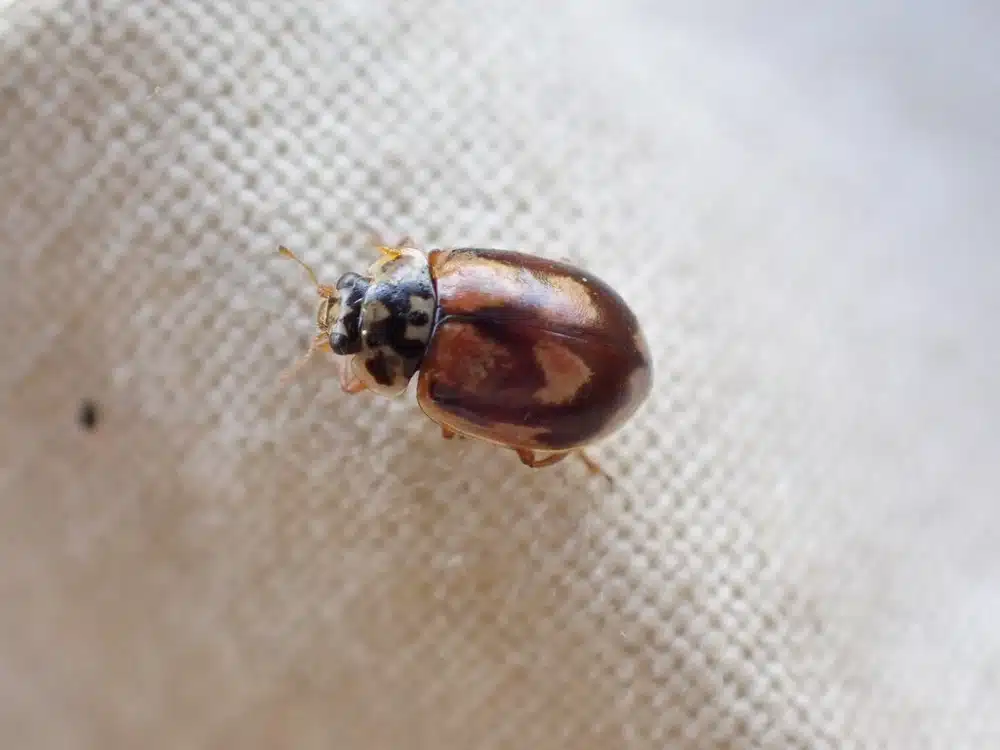
This small ladybug species (Mulsantina picta) has a bright golden color.
Painted Ladybirds are North American natives with an inclination towards higher altitude habitats.
Both US and Canadian high-elevation pine woodlands are habitats for the species.
It follows the habitat of coniferous aphids. Pine woodlands are a common sight for the Painted Ladybirds that eats pine aphids and similar soft bugs such as adelgids.
Painted Ladybirds have variable sizing, depending on the season, region, and food availability.
They are never larger than 5.3mm.
24. Bean Beetle

This type of beetle (Epilachna varivestis) is one of the detrimental species with a high impact on agriculture.
Common in Central America, it’s also found in North America on occasion. Mexican Bean Beetle populations can also migrate.
As its name implies, this is a species that lives and feeds on various types of beans such as black beans.
Both larvae and adult beetles feed on been pods and bean plant leaves.
The damage to the leaves can be considerable, essentially stopping plant growth.
It lays yellow eggs in clumps under the leaves of beans. The emerging larvae start to feed on bean leaves together with adults.
The species has few natural bug predators which include spined soldier bugs.
25. Kidney-spotted Fairy Ladybug

These types of ladybugs (Psyllobora renifer) have a white or off-white main color. Black spots contrast its elytra.Kidney-spotted Fairy Ladybug
Additional yellow, golden, or brown spots are also seen on some Kidney-spotted Fairy Ladybugs.
This species begins life as small yellow eggs that turn into transparent-white larvae.
Both larvae and the adult Kideny-spotted Fairy Ladybugs feed on plant fungus.
26. Metallic Blue Ladybug

A dark metallic blue color is specific to this species (Curinus coeruleus), as its name implies.
Characterized by having a dome-shaped body, this ladybug also has 2 large red spots on its elytra.
Metallic Blue Ladybugs feed on scale insects and have been living in The Caribbean before making their way to Southeastern US states.
Some sources claim this species was deliberately introduced in Florida to control pest bugs.
Small-scale insects are part of the diet these ladybugs have.
The species is visible throughout the year in Florida.
27. Fifteen-spotted Ladybug

A wide habitat is specific to this North American ladybug. It (Anatis labiculata) lives in a habitat expanding from Texas to the Southern regions of Canada.
These ladybugs come in multiple base colors. A gray base color, a red, and a purple color are among its main variants.
All of these ladybugs come with fifteen black spots.
These are individual spots and not fused spots as in other species.
The species is tied to trees and it’s mostly seen on trees alone, mainly for eating aphids that feed on tree leaves.
Ladybugs of this genus also feed on various mites in their coniferous high-elevation habitats.
28. Seaside Ladybug

A size of up to 6.7mm is specific to the Seaside Ladybug (Naemia seriata).
This species comes in pink or pink-red colors and it features large black elytra and pronotum spots.
Seaside Ladybugs begin life as black larvae. These bugs then change to their final colors as adults.
A common sight in coastal areas, Seaside Ladybugs are native to some US states.
Higher Seaside Ladybug populations are seen in Southwestern US territories.
29. Twice-struck Ladybug

Dorsal and ventral colors are a combination of black and red in the Twice-struck Ladybugs (Axion plagiatum).
Some ladybugs of this genus have brown undersides while their elytra are black with 2 red spots as it struck by a sword.
The round ladybug has shiny black elytra and black legs.
It grows to a size of up to 6.4mm.
Scale insects are the bulk of the diet these bugs are known for.
Twice-struck Ladybugs are found in the highest numbers across California. It’s here that they seek out soft chewable scale insects on trees.
While not an exclusively arboreal species, Twice-struck Ladybugs mostly feed on scale insects on trees with rare sights on shrubs and short plants.
30. LeConte’s Giant Ladybug
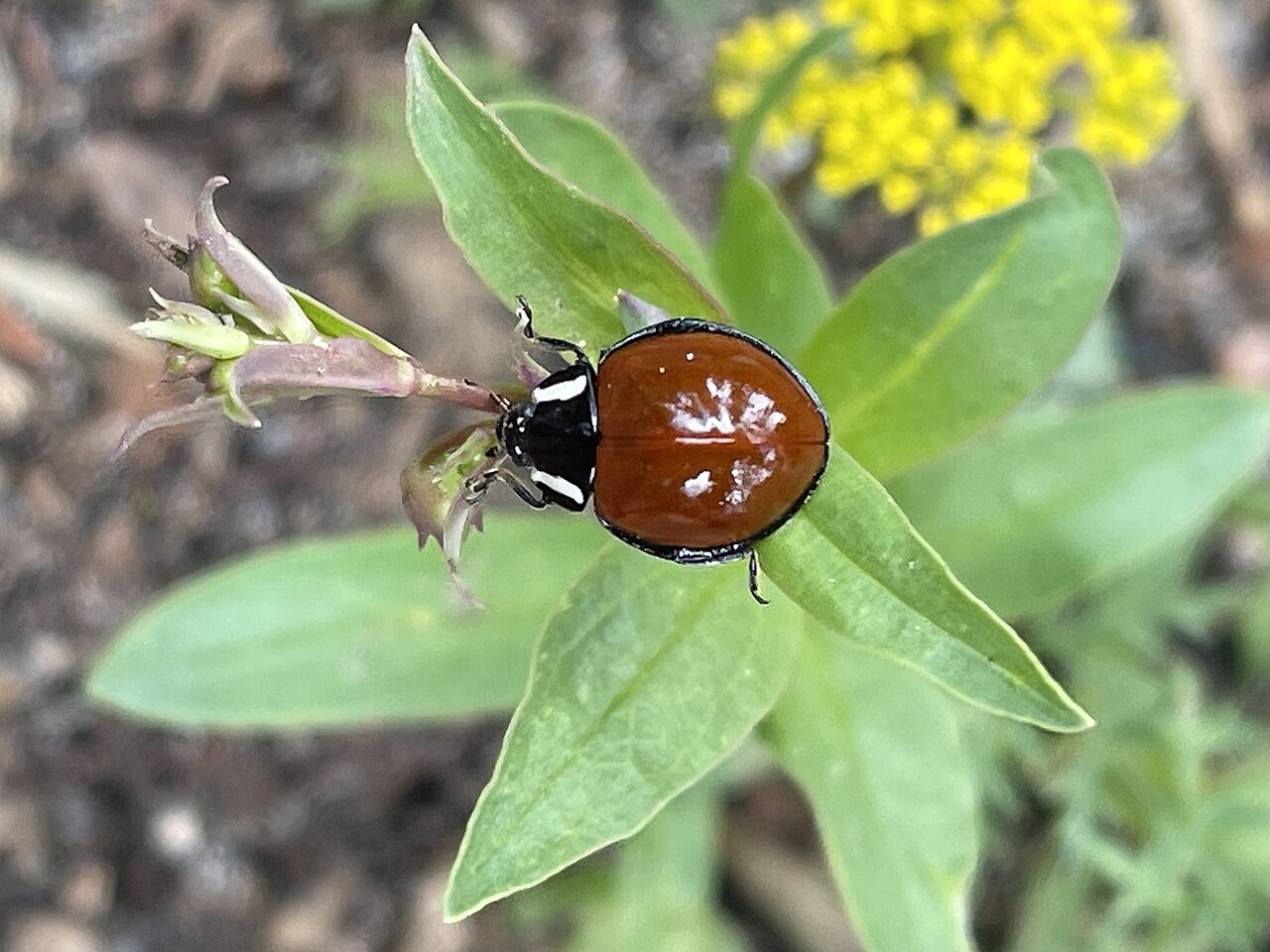
This species (Anatis lecontei) is one of the largest ladybugs in the US. It lives at high elevations and in different other dry lands across Southern states.
This species has a red, brown-red, or dark brown elytra without any spots.
It features a black pronotum with convergent yellow stripes.
Black and yellow colors are also specific to the larvae of the species which lack the brown nuances adults are known for.
This large ladybug can grow up to a size of 10.5mm.
A common sight in Texas, the species is mostly arboreal to find prey. It feeds on various species of tree aphids.
31. Steelblue Ladybug

A dark metallic blue color is uniform across this ladybug species (Halmus chalybeus). The ladybug has a worldwide presence and successfully introduced species status in Australia.
These ladybugs feed on both small insects and flower nectar.
Mites and scale insects are the primary food for these metallic ladybugs.
The species is seen at the end of April as larvae. Its coloring is different from the blue color of the adult Steelblue Ladybug.
This species has a white color with dark gray spots as larvae.
32. American Five-spotted Ladybug

Prairies along The Rocky Mountains are among the most common habitats for the American Five-spotted Ladybug (Hippodamia quinquesignata).
You can find these bugs West of Alberta, through California, and around Texas.
This is a species that comes in red or red color with orange undertones across its elytra.
The pronotum is black and it has contrasting white marks.
Like most ladybugs, it feeds on aphids and it considers other types of bugs such as scale insects as alternatives.
33. Nine-spotted Ladybug

The Nine-spotted Ladybug (Coccinella novemnotata) has 4 black spots on each elytron with 1 black spot in-between.
Native to North America, the species used to dominate Eastern habitats until the arrival of the more aggressive Asian Ladybug.
The species is still found in the Midwest on occasion.
Nine-spotted Ladybugs are also one of the official insects of New York, one of the areas it used to be found in high numbers.
This species is sometimes believed to migrate. Such evidence is seen with returning crops following crop rotation techniques or with the species appearing in new habitats following urbanization.
34. 13-Spotted Ladybug
These types of ladybugs (Hippodamia tredecimpunctata) have a base red color with 13 individual and fused black spots across the elytra.
The head and the pronotum also show black marks.
Ladybugs of the family grow to a maximum size of 6.5mm.
Aphids are the main food of the species.
As a result, the 13-Spotted Ladybug is seen on many North American crops.
Some populations are known to overwinter in warmer climates near large lakes.
35. Flying Saucer Ladybug

The Flying Saucer Ladybug (Anatis rathvoni) has a dark red color with tiny black spots across the elytra.
It has a black pronotum with large white marks.
Flying Saucer Ladybugs are some of the largest ladybugs as they can reach a size of up to 10.5mm.
They are an arboreal species closely following arboreal aphids.
Various species of pine and pine woodlands are known habitats for the Flying Saucer Ladybug.
The species lives across the West Coast from California to British Columbia.
36. Variable Ladybird Beetle

The Variable Ladybird Beetle (Coelophora inaequalis) is a species that begins life as black and yellow larvae.
It then turns into a colorful adult ladybird beetle which has different colors.
A brown, red, or even a yellow base color is specific to the species. Black fused spots across the elytra contrast these colors.
Black marks are further visible on the pronotum of the species.
This species has a confirmed status across multiple regions, including Australia.
These ladybirds feed on aphids almost all the time with occasional prey including other small insects.
37. Bigeminate Sigil Ladybug
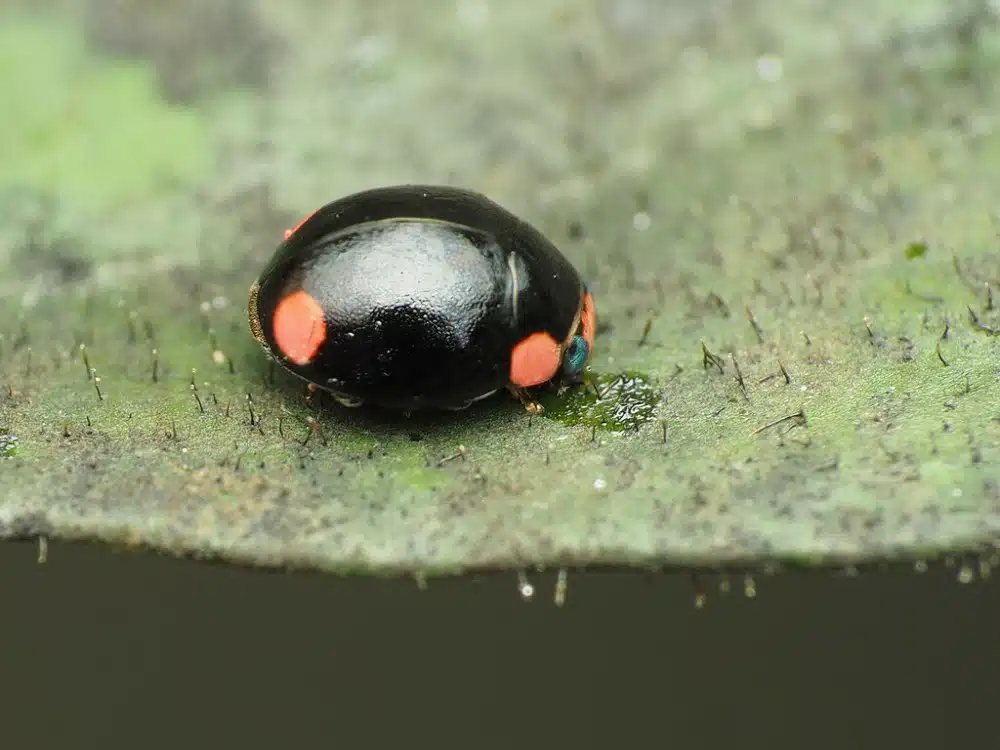
A North American native, the Bigeminate Sigil Ladybug (Hyperaspis bigeminata) is among the most common species in oak woodlands.
This ladybug has a shiny black color with 4 tiny red spots. 2 spots are on the pronotum while the other 2 red spots are on the lower elytra.
These ladybugs feed on scale insects and mealybugs given their reduced size.
Bigeminate Sigil Ladybugs only grow to a size between 2 and 3.5mm.
Their populations are high in oak woodlands where oak-feeding scale insects are common.
They can consume these insects to the point of total elimination within a forest.
38. Vedalia Beetle

Vedalia Beetles (Novius cardinalis) are a common species feeding on scale insects and very small soft-bodied insects.
It only grows to a size between 2 and 4mm which means its diet is only comprised of scale insects.
Vedalia Beetles are native to New Zealand and Australia. This species of scale insect has an introduced status in North America.
Vedalia Beetles are also seen on almost all other continents. They live in Europe and regions of Africa such as South Africa.
It was first introduced in California to combat scale insect invasions.
White and waxy cottony white cushion scale insect populations across citruses are the common prey for these ladybugs in California.
39. Streaked Ladybug
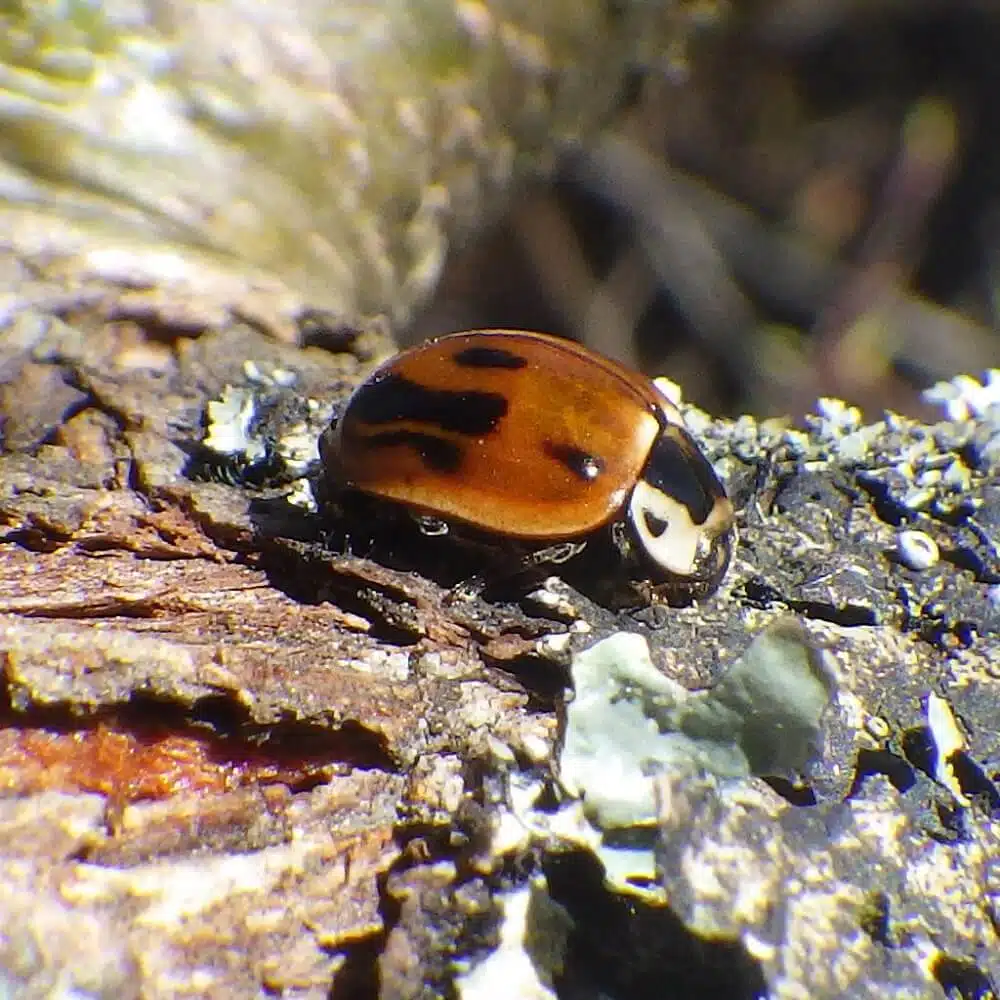
Streaked Ladybugs (Myzia pullata) are known for having an above-average size as they grow to a maximum length of 8.5mm.
These ladybugs come in different colors and they may show black or brown spots.
A few variants of the Streaked Ladybug come without spots.
Black and brown spots are seen on yellow or tan ladybugs.
A tan and dark brown ladybug without spots is also specific to the Streaked Ladybug.
These ladybugs have very specific habitats.
They only live at high elevations on conifers. However, they don’t live in woodlands as they prefer individual trees infested by aphids.
The high-elevation habitat of the species means their season ends early, in August.
40. Western Fairy Ladybug
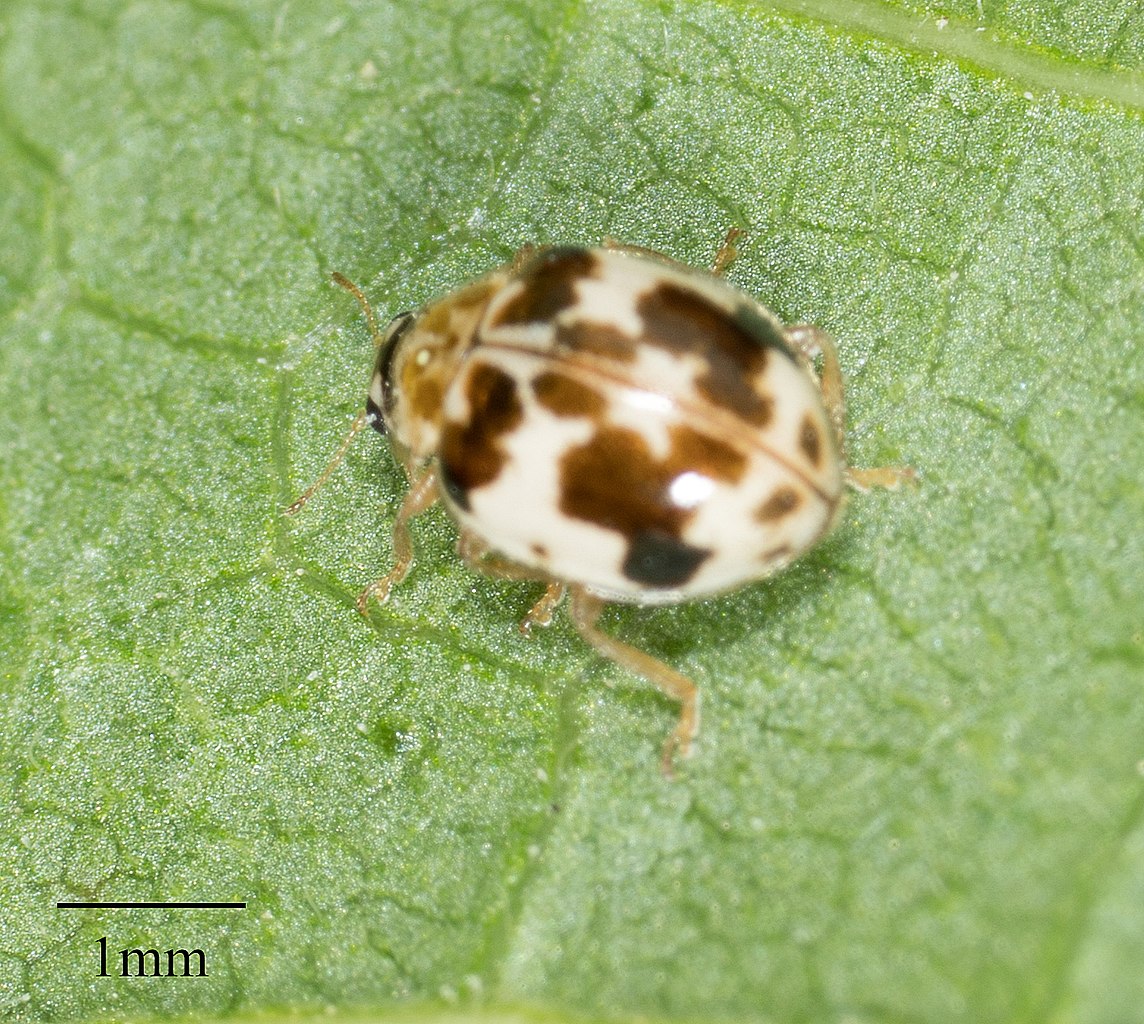
This type of ladybug (Psyllobora borealis) is mostly white. Some gray or off-white morphs exist, but they are rare.
A North American native, the Western Fairy Ladybug has black spots on the elytra.
Some morphs have an orange pronotum while others have a white pronotum.
The small ladybug exclusively feeds on plant mold. It consumes mold both as larvae and as an adult ladybug.
41. Mountain Ladybug

Mountain Ladybugs (Coccinella monticola) are not as common as other ladybugs but may still be differentiated across the US.
The species lives in a territory between Mexico and the area of The Great Lakes.
Red, brown, and orange morph are seen across the species.
The elytra of these bugs also have black spots. The spot closer to the pronotum crosses from one elytrum to another.
Mountain Ladybugs have a variable size between 5 and 7mm.
The season of the species is short, mainly limited to a period between June and August.
42. Pine Ladybird

Pine Ladybirds (Exochomus quadripustulatus) are native to Europe.
This species has a base black color with red or yellow spots. 4 contrasting spots are seen on the elytra of the species.
These spots have different shapes.
Some morphs of the species are completely red and spotless.
With a growing presence in North America and Asia, Pine Ladybirds have a common presence in coniferous woodlands.
Pine Ladybirds feed on scale insects and aphids.
43. Casey’s Ladybug

Yellow, orange, or red colors are specific to Casey’s Ladybugs (Hippodamia caseyi).
Black spots across the elytra are seen on all variants of the ladybug.
These types of ladybugs are found in poplar woodlands and other deciduous woodlands.
It’s here they get to feed on various types of arboreal aphids.
Native to Western regions of North America, these ladybugs are common between June and September.
Not all Casey’s Ladybugs die in September. Some overwinter under-leaf litter.
44. V-marked Ladybug

This species (Neoharmonia venusta) is mostly found in red and black color combinations.
The name of the species is inspired by the black V-shaped mark on the elytra. This V-shape is also backed by a few other smaller black spots across its wings.
This species is seen on various trees. Willows are among its favorite as it feeds on willow-feeding aphids.
Giant willow aphids and bark willow aphids are the common species seen on these trees.
45. Loew’s Ladybug
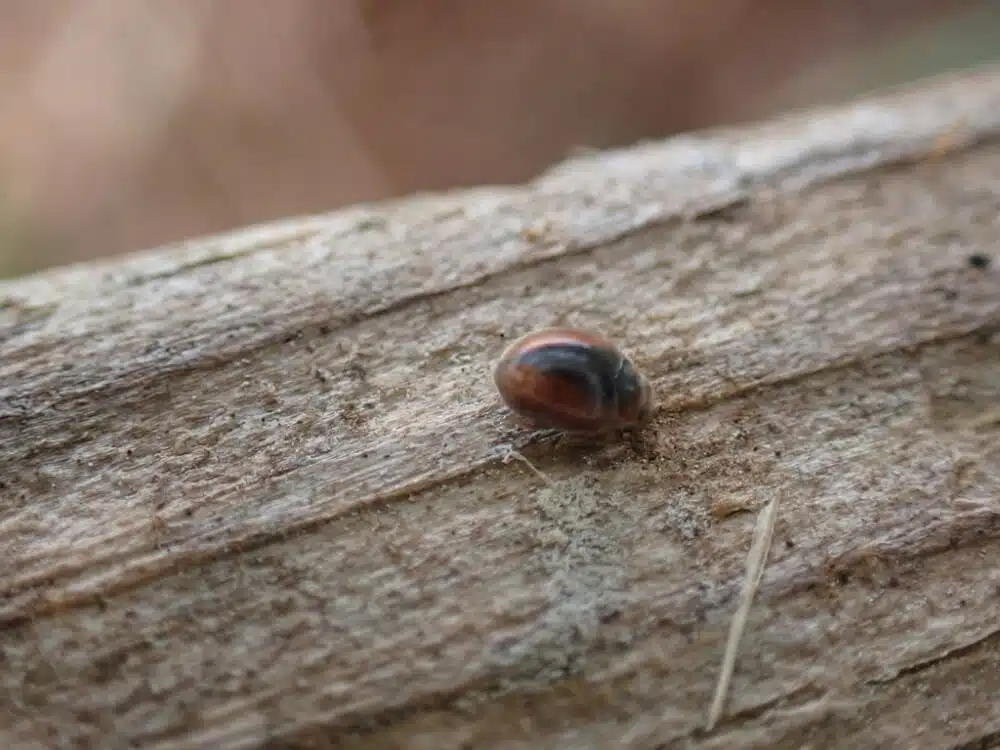
Loew’s Ladybugs (Scymnus loewii) are some of the smallest bugs of the species.
It grows to an average of 2mm in size as an adult. A combination of brown and black colors is specific to the species.
Black is its base color as brown sections are variable, typically seen on the elytra margins and its head.
This is also one of the ladybirds with short hairs, which are often too small to be visible to the naked eye.
Loew’s Ladybug has white elongated larvae that feed on leaves.
46. Heather Ladybird

This black ladybird species (Chilocorus bipustulatus) grows to 5mm.
The black base color is specific to this type of ladybird. The species also comes in a brown-red rare variant.
Its common black appearance is contrasted by a straight row of red dots across the elytra.
The larvae of the species have an elongated shape with black color spikes and a tan central band.
Its habitat is diverse, ranging from woodlands to parks and gardens.
In some areas of the world, the species also lives on short vegetation.
47. Trident Ladybug
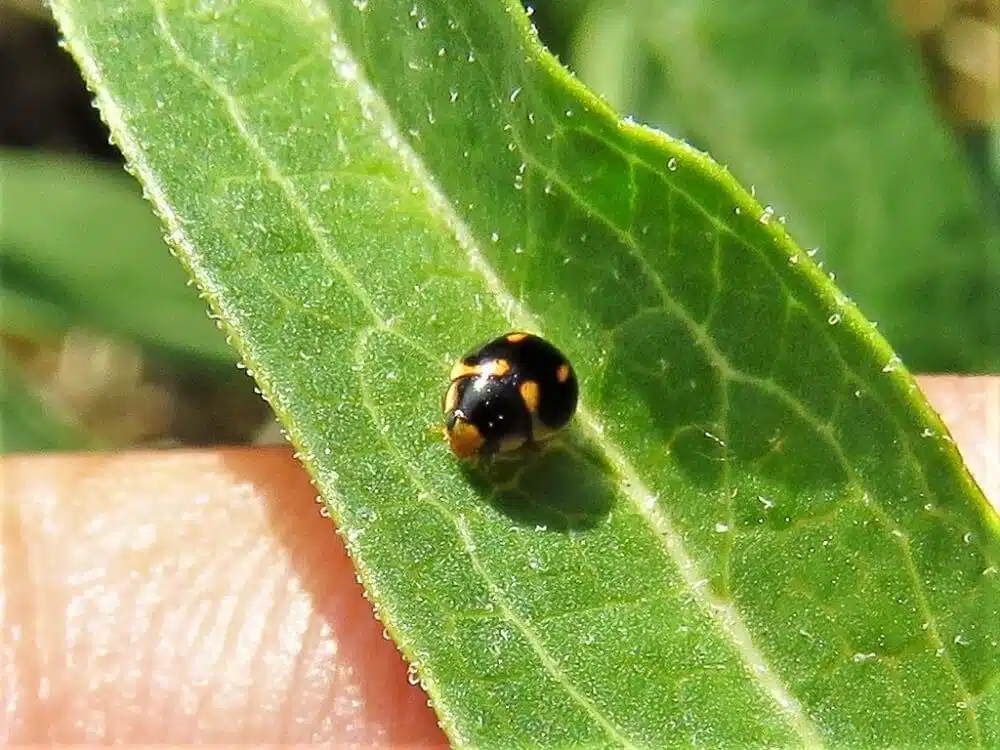
A combination of black and brown or black and tan colors is specific to this type of ladybird (Hyperaspis trifurcata). The species has a few vertical stripes across its black elytra.
This species only lives in arid or very warm climates in the world. It can be found in Southern Texas in the US where it seeks out specific types of scale insects.
Cochineal scale insects seen in various cacti attract the Trident Ladybug to this part of the country.
Trident Ladybugs are also found in Southern California and Southern Florida.
48. Cream-spotted Ladybird
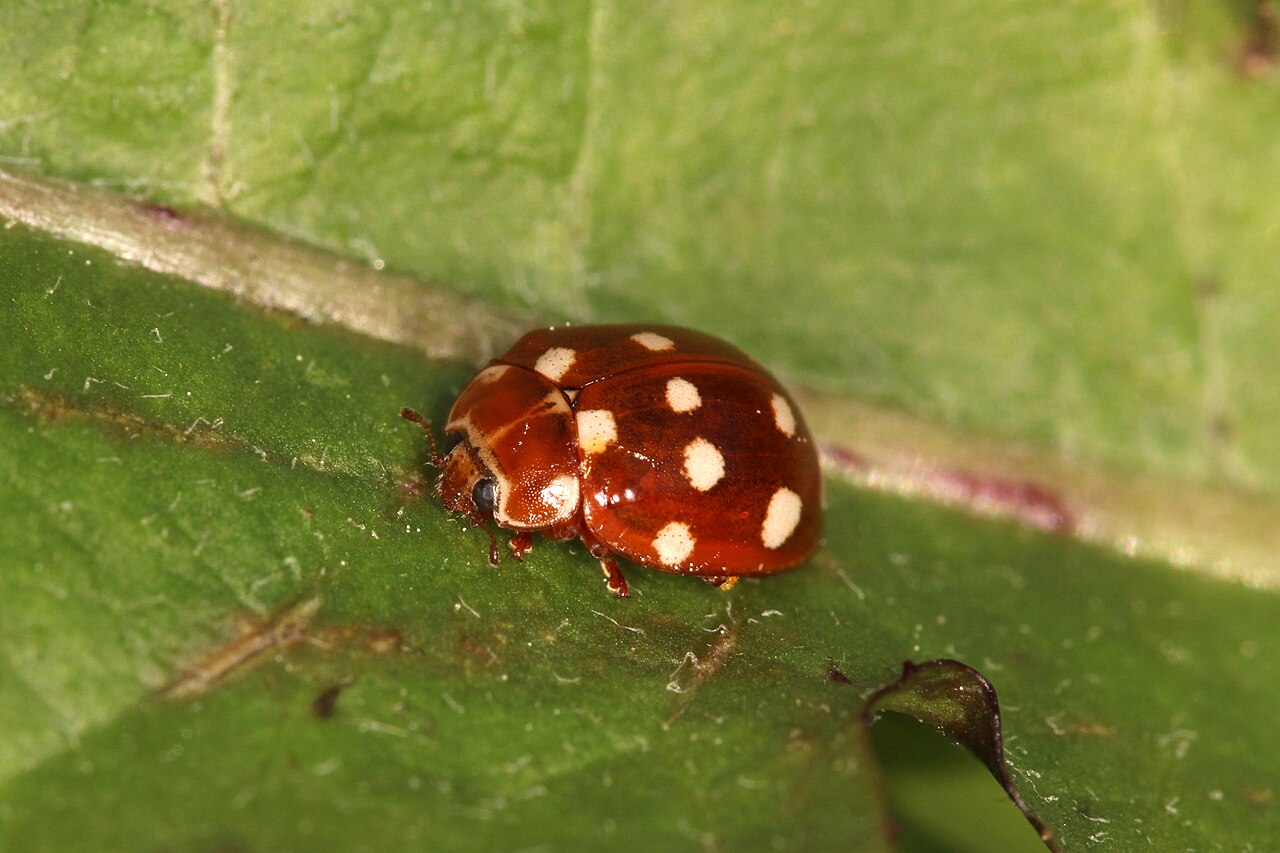
This species (Calvia quatuordecimguttata) is named after its light brown color with white spots.
Growing up to a size of 4.5mm, the Cream-spotted Ladybird is found in an expansive North American habitat, including Alaska.
This species is a common sight in woodlands as it preys on various tree-dwelling aphids.
It eats aspen and willow aphids so it spends most of its life on the tree canopy.
49. Thrice-struck Ladybug
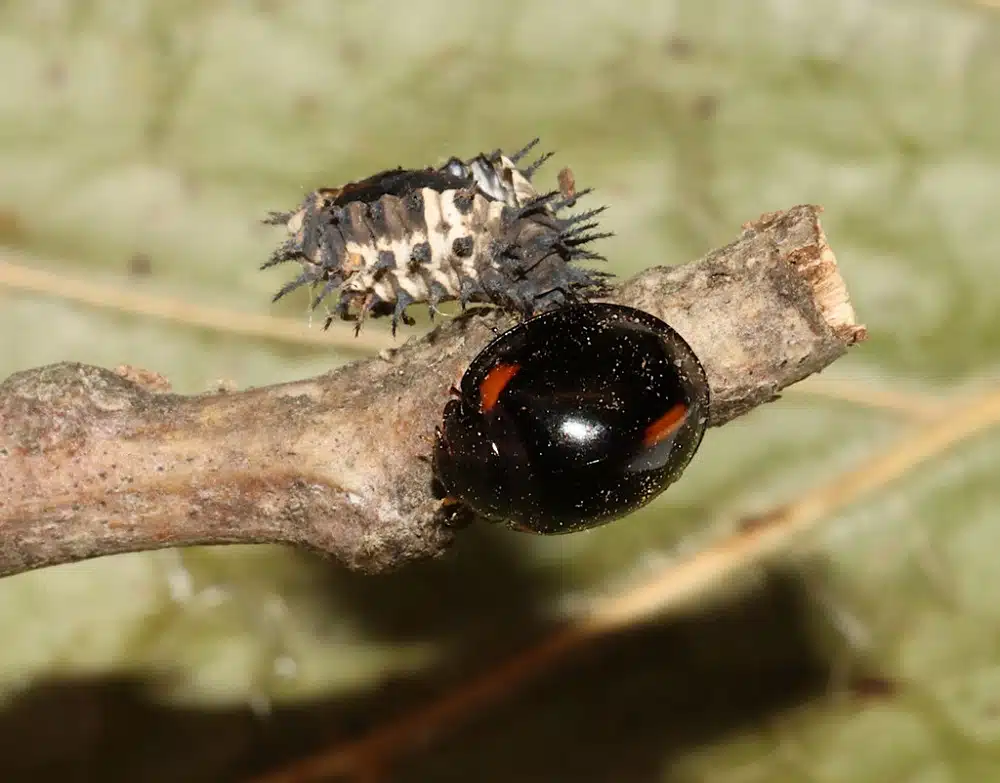
With an average size of 3mm, the Thrice-struck Ladybug (Axion tripustulatum) is a North American Native.
This ladybug resembles the Twice-struck Ladybug the most.
The main difference is in the number of red spots, as its name implies.
With a black base color, this species has 3 red spots on its body.
Ventral coloring of the species is mostly red or dark red while its legs are black.
50. Sinuate Ladybug
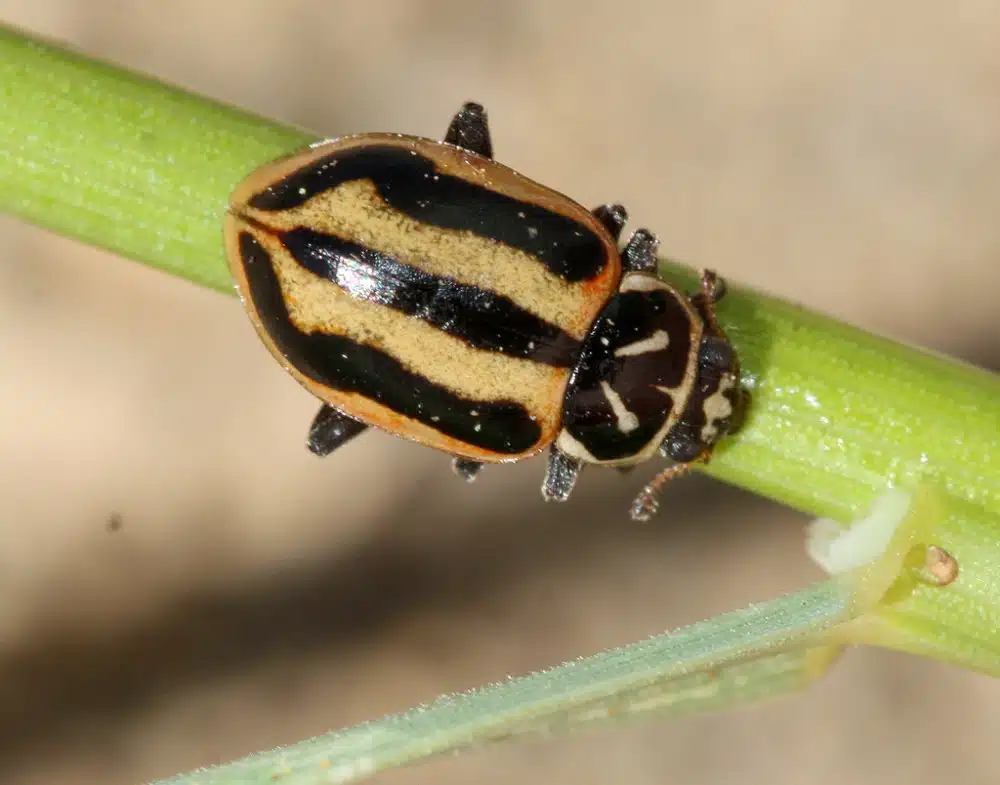
A pale orange color is specific to the Sinuate Ladybug (Hippodamia sinuata).
This species appears darker orange in its first days of life and it gets lighter as it ages.
Black spots and a black line are seen on its elytra. The pronotum is black with convergent white lines but without any spots.
51. Broad-striped Ladybug
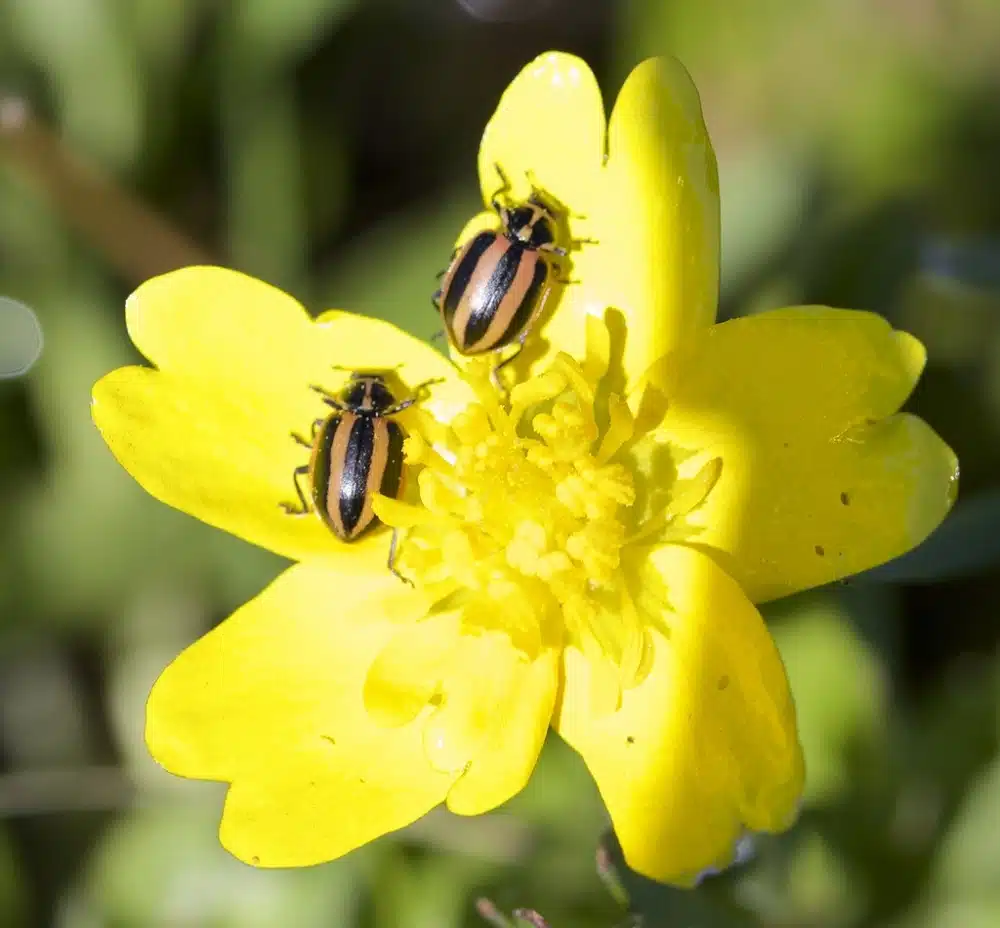
Seen up until September, the Broad-striped Ladybug (Paranaemia vittigera) is an active ladybug with contrasting elytra.
The species has a pink to violet base color with 3 black vertical stripes.
Some rare forms of the species are yellow with black stripes.
The pronotum is also marked by these contrasting color combinations.
The yellow and black morph of the Broad-striped Ladybug is sometimes confused with The Colorado Beetle.
52. Glacial Ladybug

Yellow, orange, and brown are the colors the Glacial Ladybug (Hippodamia glacialis) can come in. These are the base colors of the elytra always contrasted by black spots.
The pronotum is also black with converging yellow, orange, or brown lines.
Unlike similar species such as the Oblong Lady Beetle, Glacial Ladybugs only have black spots on the lower elytra.
53. Ten-spotted Spurleg Ladybug
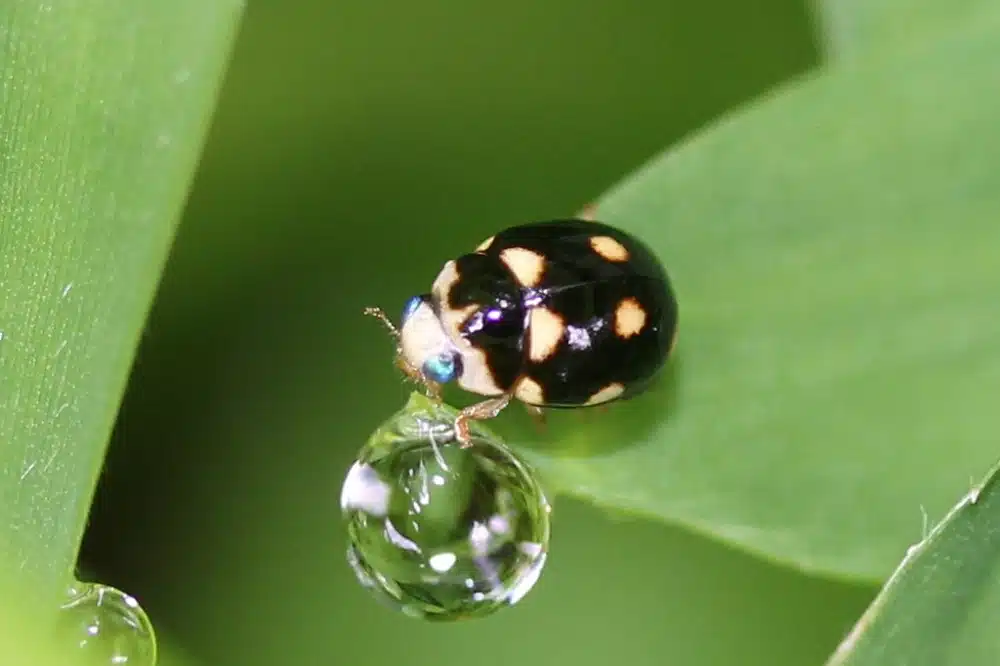
Black and tan are the main colors of the Ten-spotted Spurleg Ladybug (Brachiacantha decempustulata). 4 spots are seen on the elytra while one bright spot is seen on the pronotum.
This species is one of the smallest ladybugs in North and Central America. It has a size of up to 2.5mm but many individuals are as small as 2mm.
Ten-spotted Spurleg Ladybugs feed on aphids.
54. Marsh Ladybug

Native to North America, Marsh Ladybugs (Anisosticta bitriangularis) live in humid habitats.
They live in areas with high humidity and low vegetation. Mark Ladybugs have a yellow-orange color with black spots across the elytra and on the pronotum.
A white variant with black spots is also common.
Marsh Ladybugs feed on scale insects and aphids.